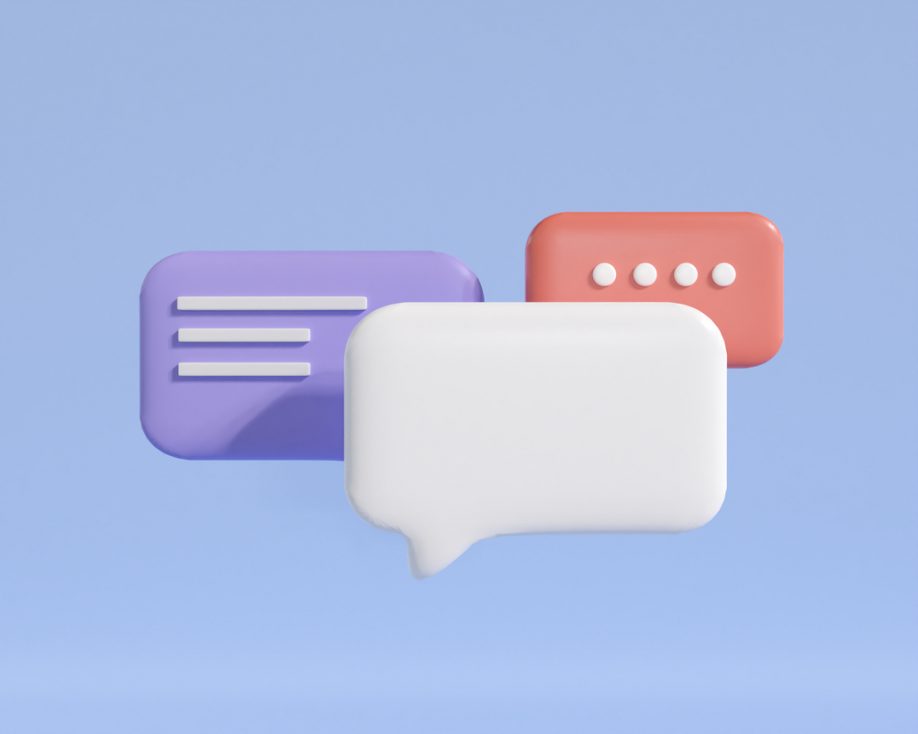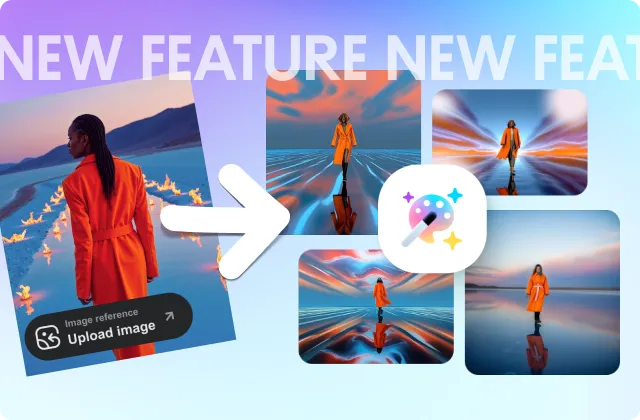20 Best AI Chatbots for Work, Fun, and Education
When ChatGPT burst onto the scene, it became a real sensation in the market. Even today, it’s considered one of the best AI chatbots. Thanks to the development of new language models, artificial intelligence technologies have significantly simplified people’s lives, allowing them to perform part of their work tasks, efficiently plan time, monitor health, and just have fun.
Are there solid ChatGPT alternatives? Let’s figure it out in this article, which introduces 20 handy chatbots for various tasks—covering everything, from work to entertainment. Also, keep reading to discover practical solutions and get tips on making the most out of these smart assistants.
TOP 20 best chatbots with artificial intelligence
Although all AI-based chatbots can engage in conversations, each of them is suitable for different tasks. For example, one solution might be great for crafting texts, while another is geared towards finding information swiftly. In this list, you will find solutions for addressing marketing tasks, interacting with fictional characters, monitoring health, etc.
- Google Bard
- Replika
- Jasper
- Character AI
- ZenoChat
- Buoy Health
- Microsoft Copylot (formerly Bing)
- Woebot
- Drift
- HuggingChat
- WriteSonic
- YouChat
- Personal.ai
- Pi
- Poe
- Github Copilot
- Claude
- Khanmigo
- Perplexity
- KoalaChat
1. Google Bard
Google Bard is a popular free ChatGPT alternative. Unlike its competitor, it utilizes up-to-date databases sourced from the internet. Early access to this chatbot was opened on March 21, 2023. Now, it’s available to users in 230 countries without any limitations. In contrast to the basic features of ChatGPT, Bard integrates with your Google account, allowing you to fact-check information on the internet and listen to responses.
- Price: free
- Best for: sourcing data, multilingual translations, summarizing topics, and providing up-to-date information.
- Query limit: unlimited
- Language models: LaMDA (earlier), PaLM 2 (currently).
- Pros: Information relevance, ability to clearly understand user prompts, text adaptation to various styles and formats (news articles, messages, letters, social media posts, etc), real-time access to websites, syncing with Google accounts, additional features (sharing responses, verification, listening), multiple response options for a single question.
- Cons: Inaccuracies in responses, lack of creativity, absence of source references, occasional inconsistencies in answers, limited generative capabilities (unable to write lengthy articles, create artistic works, generate detailed graphics, and produce extensive lines of code).
- Key features: Human-like conversations, text generation, translation, coding, question answering, voice command support, Google product integration
2. Replika
Replika is an AI chatbot that simulates real-life conversations. You can create your unique fictional characters tailored to your communication style. They frequently provide emotional support and helpful advice. This application was released in 2017, predating the introduction of ChatGPT. Replika characters learn from user responses to their questions, making each created character unique over time.
- Price: The freemium pricing model. $19.99 per month for Replika Pro. Or, a lifetime fee of $299.99
- Best for: Casual chats, enjoyable pastimes, and mental well-being enhancement.
- Query limit: Unlimited, but your characters might need a break if you chat with them for too long.
- Language model: GPT-3
- Pros: Free options, accessibility from different devices (PCs, smartphones, and tablets), customizable characters, and social features (for example, you can dress up your AI friend however you want).
- Cons: Lack of context understanding, inaccurate answers, the possibility of deep fakes generation, data privacy intransparency.
- Key features: Personalized AI companions with deep emotional connection, empathetic conversations, memory and relationship history, customizable avatars, goal-setting functions, the diary feature, voice and video calls, and mini-games.
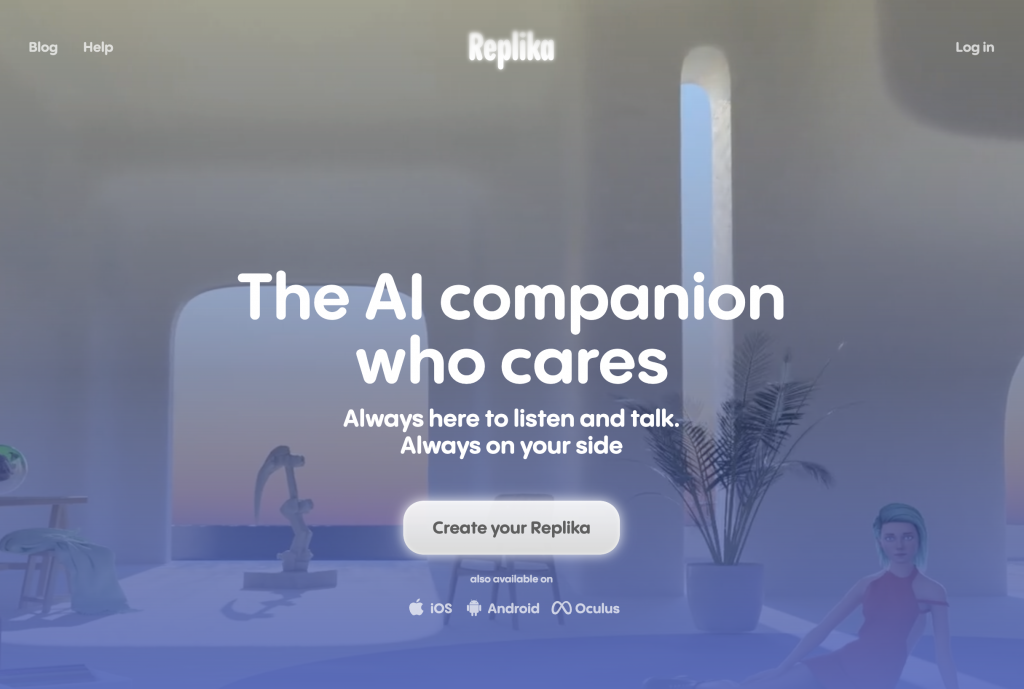
3. Jasper
Jasper serves as an AI platform, assisting businesses in expanding their marketing content across various channels such as blog articles, social media posts, sales emails, website copy, and more. Jasper can analyze your business’s raw data to generate unique texts tailored to your target audience. To do this, you’ll need to upload information to the platform. This application is fully confidential.
- Price: Several pricing plans ($49 per month for Creators, $125 per month for Teams, and unique propositions for Business). It’s also available for yearly billing options.
- Best for: Content marketing promotions across various channels.
- Query limit: Unlimited.
- Language model: GPT-4
- Pros: Available in 30+ languages, content optimization to different marketing channels (social media, blog posts, emails, etc), on-brand AI assistance, project management features, insights, and advanced content performance tips.
- Cons: Not always good text quality, requires careful input, expensive, limited in content types.
- Key features: Long- and short-form content generation, improvement features, research options, SEO optimization, marketing collaboration tools, multiple languages, and AI-powered recommendations.
4. Character AI
Have you ever wanted to engage in small talk with Elon Musk or discuss philosophy with Aristotle? Thanks to Character AI, it’s now possible. It allows users to create characters with specific personality traits and then share them with others. For example, you can model a hero from your favorite book, video game, or movie. This platform was created by former Google developers and became accessible in September 2022.
- Price: The freemium pricing model. Character AI Plus is $9.99 per month.
- Best for: Pleasant conversations, learning more about AI, skills improvement (such as writing, research, languages, etc), getting emotional support, and creative content generation.
- Query limit: Unlimited upon registration.
- Language models: Unique deep learning and large language models.
- Pros: Possibility of creative expression, good storytelling narratives, characters with diverse backgrounds, language practice options, creative writing assistance, role-playing features, and mental health support.
- Cons: Requires time to train your personal AI.
- Key features: Knowledge gaps, overzealous content filters, inconsistency in narratives, limited character memory, data usage concerns, and lack of emotional intelligence.
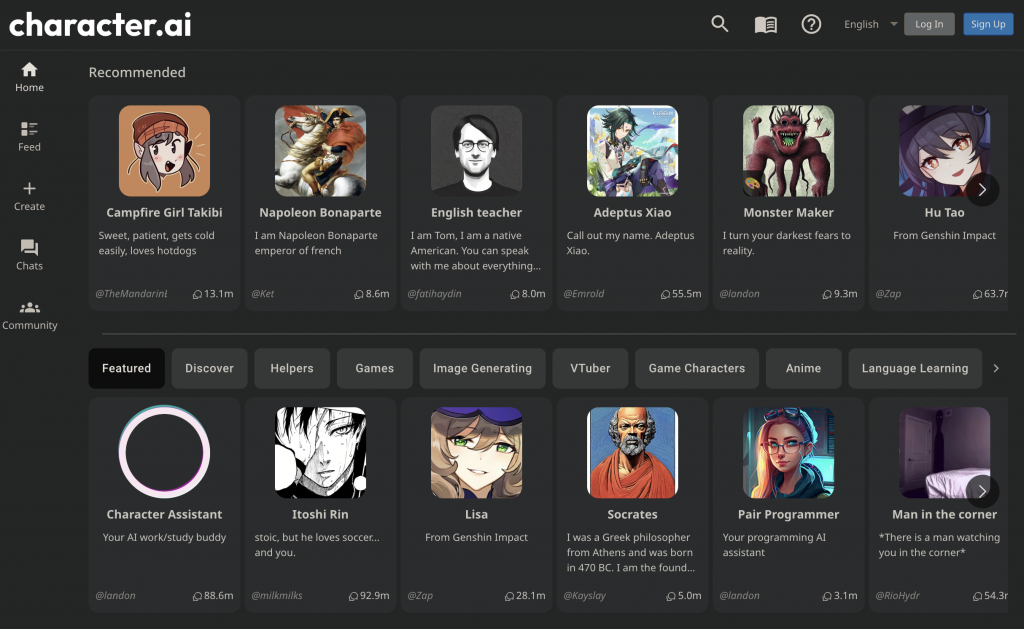
5. ZenoChat
ZenoChat is an AI-powered chatbot that can be customized to fit your specific needs. For example, it allows you to choose a language model, unique communication styles, and information bases. ZenoChat can be a valuable tool for various purposes, including data retrieval and marketing plan creation.
- Price: The freemium pricing option. Advanced features and unlimited queries are available under different plans ($23.99 for Lite and $83.99 for Unlimited).
- Best for: Writing assistance, translations, content search engine optimization, marketing support, information gathering, and entertainment.
- Query limit: 50 queries after registration and 20 each day in the free version.
- Language models: GPT-4, Sophos-1, Sophos-2 (can be chosen manually).
- Pros: Versatility, free options, multipurpose content generation, advanced filters, available as a browser extension, includes multiple tools like summarization and YouTube video description, research capabilities in 25+ languages.
- Cons: Lack of fact-checking, context retention, memory limitations, query limitations in the free version, risks of misinformation,
- Key features: Filtering system, SEO assistance, multilingual capabilities, browser extension, voice search options.
6. Buoy Health
Buoy Health is a way to receive personalized medical recommendations and identify worrisome symptoms of illness. This platform has been developing thanks to Harvard Medical School since 2014, and is considered one of the smartest healthcare AI systems.
- Price: Free
- Best for: getting personal medical recommendations and symptom identification.
- Query limit: Unlimited
- Language model: Undisclosed
- Pros: Symptoms triage, personalized recommendations, healthcare provider connection, secure access.
- Cons: Limited responses (you should choose from the provided options), potential diagnostic inaccuracy, and possible misdiagnosis.
- Key features: Personal instructions after evaluating symptoms, closed symptom tests, and the possibility of connecting with healthcare providers.
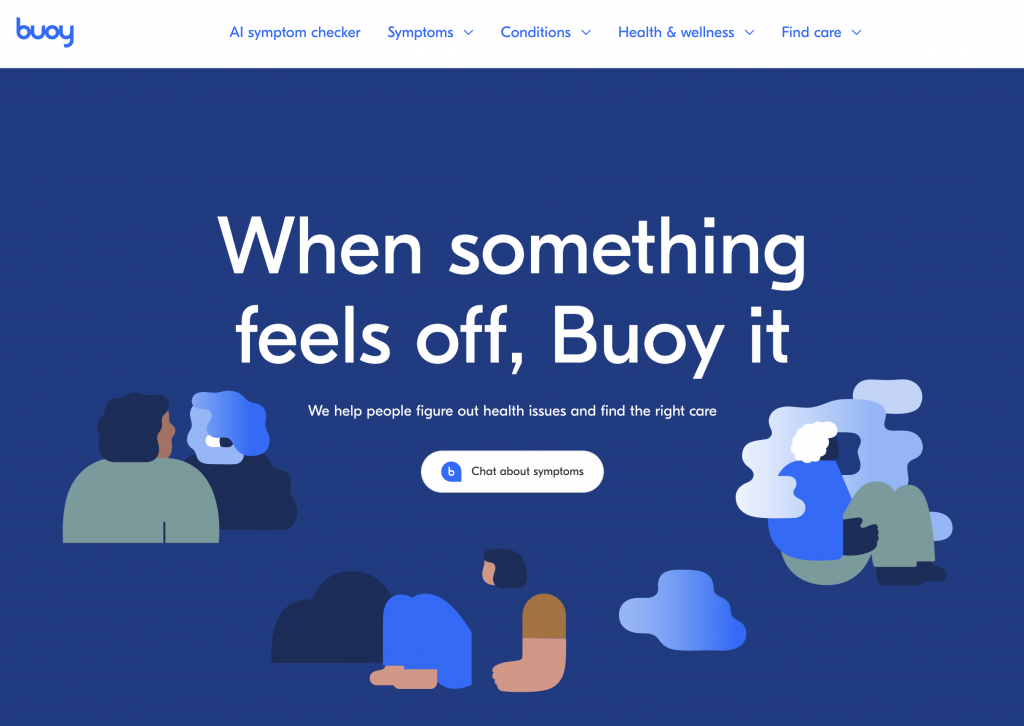
7. Microsoft Copylot (formerly Bing AI Chatbot)
Bing is a popular search engine. In February 2023, Microsoft also added an AI chatbot function to it. It can generate unique images based on textual descriptions, search for relevant information, and adapt to various writing styles. Thanks to this advancement, the popularity of the search engine has increased, reaching a user base of 100 million.
- Price: Free
- Best for: Information gathering, image generation, and writing assistance.
- Query limit: Unlimited.
- Language model: GPT-4
- Pros: Vast, actual knowledge base, ability to generate different creative content formats, personalized recommendations, support in 25+ languages, provides reference materials, different conversation styles.
- Cons: misinformation risks, monotypic answer style, slow response time.
- Key features: conversation style filters, voice search, image generation, chat history, and safe search.
8. Woebot
Woebot was developed by Stanford psychologists and artificial intelligence specialists specifically to help people worldwide take care of their mental health. Woebot can engage in therapeutic conversations, track moods, and provide various interactive games. This platform was founded in 2017 by clinical research psychologist Dr. Alison Darcy.
- Price: Free, but available only for users in the United States.
- Best for: Therapeutic conversations and well-being enhancement.
- Query limit: Unlimited.
- Language model: Undisclosed.
- Pros: Multiple therapy approaches (Cognitive Behavioral Therapy, Interpersonal Psychotherapy, and Dialectical Behavioral Therapy), non-judgemental interactions, solutions for different age groups, personalized guidance, and data protection.
- Cons: Region and device limitations, lack of human interactions, can become repetitive, doesn’t work for everyone.
- Key features: Therapeutic effect, mood tracking, interactive conversations.
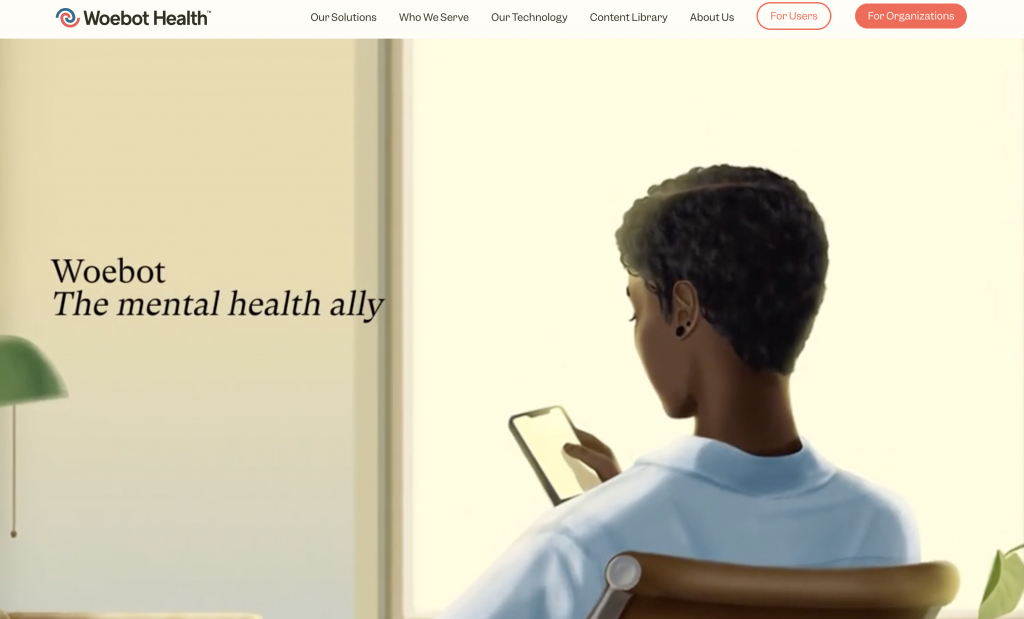
9. Drift
Drift is a conversational marketing platform designed to improve customer service and lead generation. Utilizing AI-powered chatbots, it can engage, qualify, and convert potential buyers seamlessly from any page on your website.
- Price: Depends on the plan ($2,500 per month for Premium, custom rates for Enterprise and Advanced).
- Best for: Marketing and sales process optimization.
- Query limit: Unlimited.
- Language model: GPT-4
- Pros: Improved customer interactions, the possibility of integration with your business systems, delivering valuable marketing and sales insights.
- Cons: chatbot set up and training requires a lot of time, limited control over personalization, and expensive subscription plans.
- Key features: Chatbots integrated into email campaigns, intent recognition, proactive engagement with website visitors, personalized product/content recommendations, automatic lead qualification, real-time analytics, and API integration options.
10. WriteSonic
While many AI chatbots can provide useful answers, most of them are not adapted for writing long articles. This problem is addressed by WriteSonic. According to the creators of the project, this tool can reduce the time spent on writing quality long-form content by 80%.
- Price: Several options are available. The free version has limits of up to 10,000 words per month. The Freelancer package costs $16 per month, the Small Team — $13 per month, and the Enterprise — $500+ per month.
- Best for: Speeding up article creation.
- Query limit: 10,000 words/month in the free version
- Language models: GPT-3.5, GPT-4 (depends on the chosen package).
- Pros: Content versatility, very similar to human writing, cost-effective in comparison to hiring copywriters, search engine optimization options.
- Cons: Limited customization, lack of advanced editing features, occasional bugs.
- Key features: Long- and short-form writing options, built-in plagiarism checker, grammar checker, multilingual support in 25+ languages, company data integration features, keyword research, and competitor content analysis.
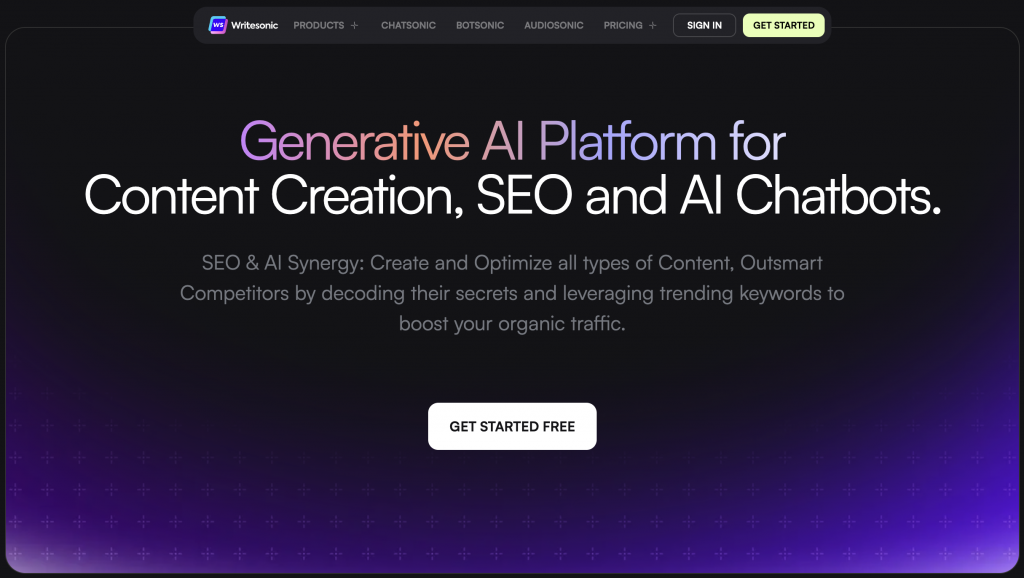
11. HuggingChat
HuggingChat is developed by the Hugging Face company which has been engaged in this area since 2016. The platform allows users to exchange various models and datasets. Similar to other AI-based solutions, HuggingChat can craft texts, make summaries, and write multiple content. It can also debug and write code, formulate Excel functions, and address general inquiries in a manner akin to ChatGPT.
- Price: Free
- Best for: Information research, content writing assistance, data structuring, and code debugging and creation.
- Query limit: Unlimited
- Language models: Llama 2, CodeLlama, Falcon, Mistral.
- Pros: Good code writing capabilities, open-source collaboration, multiple NLP models, user-friendly interface.
- Cons: Limited language support, misinformation, and data privacy concerns.
- Key features: Switching between models, web search, advanced code writing options, open-source.
12. Personal.ai
Ever thought about having a digital twin you can teach and ask to gather your latest knowledge? That’s what the Personal.ai platform does. It acts as your assistant, helping with personal or work tasks. For example, you can have it plan your day based on your workload. You can also chat with default bots to experiment with different communication styles.
- Price: Completely free for personal use, but has memory limitations. For business utilization, prices start from $15+.
- Best for: Boosting productivity, creative expression, and AI companionship.
- Query limit: Unlimited, but necessary information is stored as a memory stack (100 points in the free version).
- Language models: Custom, based on your unique experience.
- Pros: Personalized assistance, availability across different platforms (PCs and mobile devices), personal directory with necessary information, and the possibility to chat with different chatbots.
- Cons: Limited context understanding, requires time to train your personal AI, memory limitations in the free version.
- Key features: Personal AI development, chatting with AI friends, public lounges covering multiple topics.
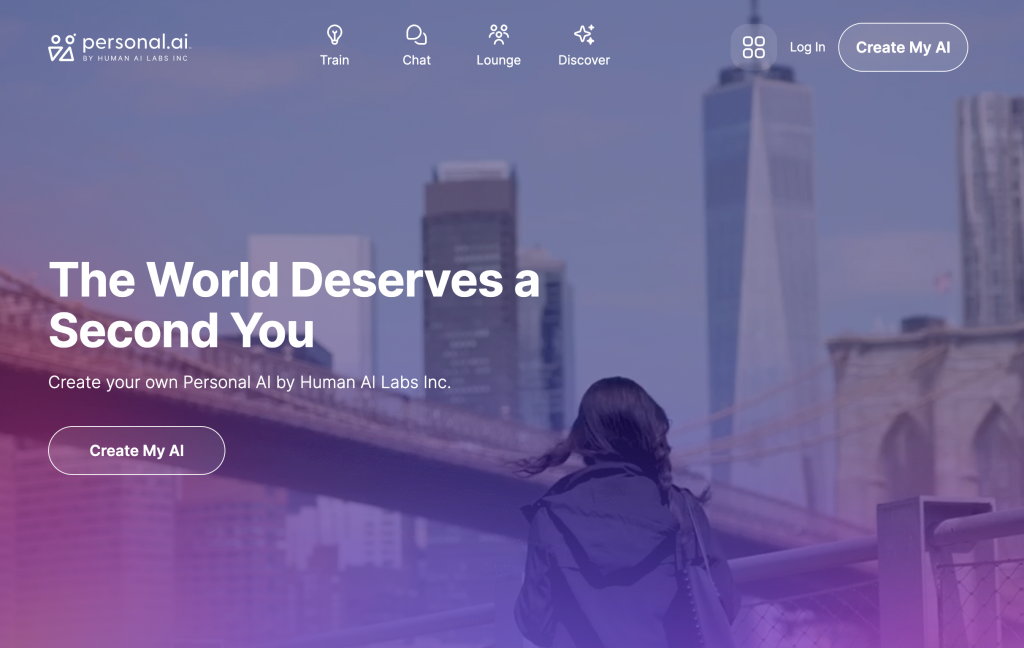
13. YouChat
Launched in December 2022, this AI-powered conversational chatbot can respond to your questions, generate ideas, translate text, summarize articles, compose emails, and generate code snippets. Unlike ChatGPT, its free version has an up-to-date database and can cite sources. In February 2023, the developers updated its functionality, making it more conversational. It can also create long-form articles, generate images from textual input, and enhance the resolution of uploaded images. This platform also has a mobile version.
- Price: Multiple options, including the free version with limitations. The YouPro version costs $9.99 per month, while the price for organizations is up for discussion.
- Best for: Information research, idea generation, multilingual translation, image generation, and writing articles.
- Query limit: Unlimited for information searches, 10 free image and article generations per month in the free version.
- Language model: GPT-3.5 (in the free version), GPT-4 (in the paid version).
- Pros: Up-to-date information, ability to generate different content forms, creative text formats, security transparency, and image generation.
- Cons: Intrusive writing style, new features need refinement.
- Key features: Different content type creation, actual database, available for mobile devices and as a browser extension.
14. Pi
Pi is a one-of-a-kind AI-driven chatbot created by Inflection AI. Its purpose is to offer users a unique experience of emotional support. The developers claim that Pi is not just capable of maintaining interesting conversations, but also embodies kindness, diplomacy, and humor. They’ve positioned the chatbot as having a more robust emotional intelligence when compared to ChatGPT.
- Price: Free.
- Best for: Friendly conversations and discovering multiple topics from different points of view.
- Query limit: Unlimited.
- Language model: Inflection-1.
- Pros: The possibility to discover different topics, human-like writing manner, creative content generation, open-source platform, strong focus on privacy, and multilingual support.
- Cons: Inaccurate answers and slow response time.
- Key features: The Discover section with different topics to discuss, a unique writing style, and six voice settings for text voicing.
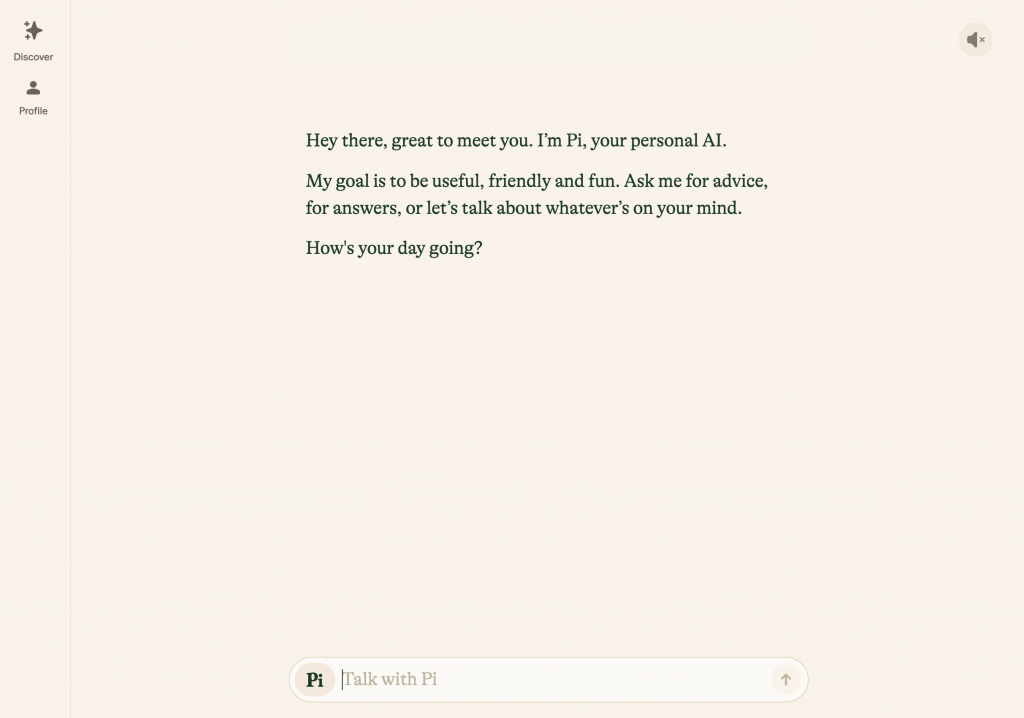
15. Github Copilot
Github Copilot is the most advanced OpenAI chatbot for programming. For example, it can help engineers improve code quality with prompts, provide real-time suggestions, and generate pull requests. Github Copilot is a collaboration between Microsoft and OpenAI, first released in 2021.
- Price: $10 per month for individuals, $19 per month for businesses (one user), and $39 per month for enterprises (one user).
- Best for: Programming.
- Query limit: Unlimited.
- Language model: OpenAI Codex.
- Pros: Increased productivity, improved programming accuracy, tailored to specific programming needs.
- Cons: Lack of free version, misleading code at times.
- Key features: Code completion, boilerplate generation, function generation, autocomplete feature, multi-line generation, context awareness, coding style customization.
16. Claude
Claude is considered one of the best AI chatbots, as it was developed by former researchers from OpenAI. Like other solutions, the platform enables users to exchange messages with artificial intelligence. In training Claude, Anthropic PBC utilized the Universal Declaration of Human Rights from 1948 and Apple’s terms of service. This approach aimed to create a solution that prioritizes maximum confidentiality.
- Price: Has a free version with a 100,000 token limit (approximately 75,000 words). Claude Pro costs $20 per month.
- Best for: Reasoning, creativity, friendly dialogues, coding, and content creation.
- Query limit: 75,000 words in the free version + x5 in the paid version.
- Language models: Claude Instant (in the free version), Claude 2.0, Claude 2.1.
- Pros: High security, the ability to analyze your personal attached documents, multiple language models.
- Cons: Limitations even in the paid version, slow response time, still under development.
- Key features: Attached content, documents memory, chatting.
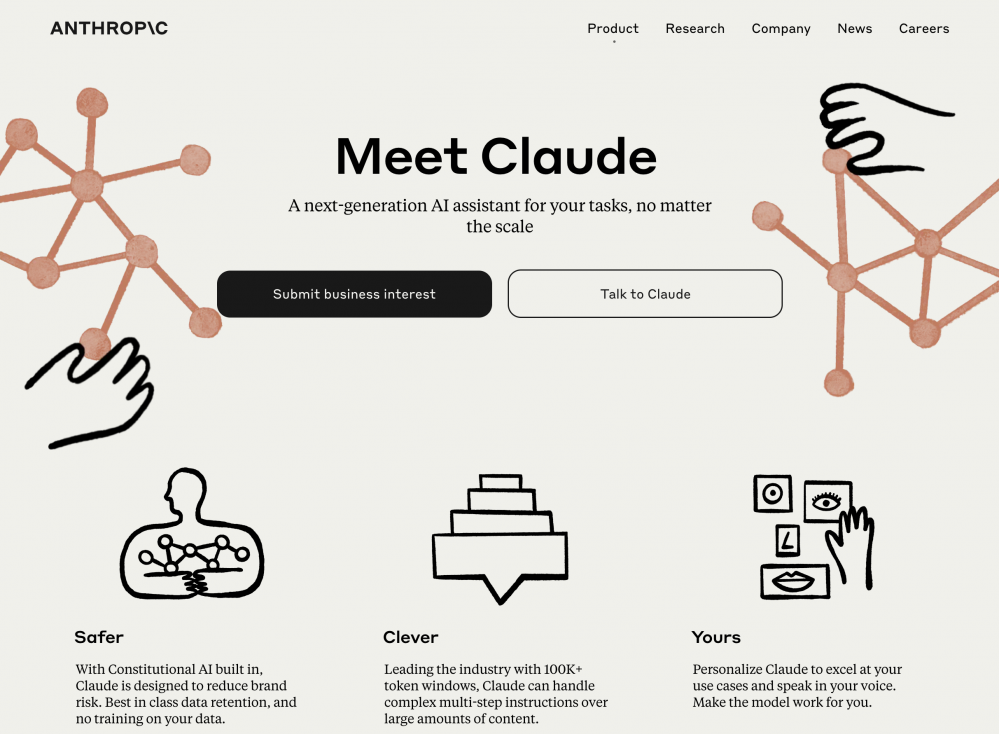
17. Poe
Poe is an entire platform for creating your unique chatbots with artificial intelligence. It was developed by Quora and released in December 2022. Its uniqueness lies in the ability to experiment with various language models.
- Price: Free
- Best for: Experimenting with artificial intelligence.
- Query limit: Unlimited
- Language models: ChatGPT, GPT-4, DALL-3, Claude Instant, Claude 2, StableDiffusionXL, PaLM, Llama 2, and unique community language models.
- Pros: Chatbot customization, multiple language models, solutions customized for different needs (writing, roleplay, programming, etc).
- Cons: Requires experience in educating chatbots.
- Key features: The Discover section with different language models, chatbot creation, chatbot management, other creators, and accessibility from multiple platforms (PCs and mobile devices).
18. Khanmigo
Khanmigo is perfect for self-learning and assisting teachers. For instance, students can use this solution to help with solving mathematical problems or acquiring specific knowledge. Khanmigo aids teachers in addressing administrative tasks, such as lesson plan writing. This chatbot was released by Khan Academy in March 2023.
- Price: $4 per month or $44 per year, but it’s only available for US citizens.
- Best for: self-education and developing learning plans.
- Query limit: Unlimited.
- Language model: GPT-4
- Pros: Personalized learning experience, 24/7 access in comparison to human tutors, available Khan Academy content library, academic and career guidance options.
- Cons: Limited availability in specific regions, limited subjects (focuses primarily on art and math).
- Key features: Engaging learning through a conversational interface, interactive games, progress tracking, and Khan Academy content integration.
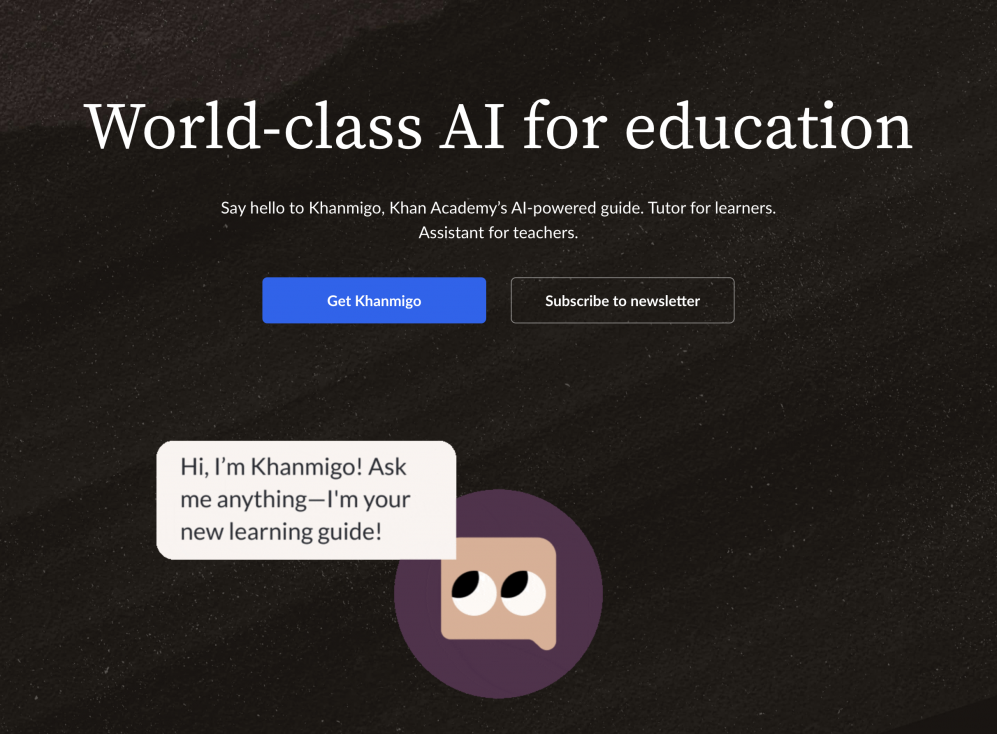
19. Perplexity
Perplexity is the best conversational AI chatbot utilizing expansive language models to offer solutions to intricate queries. Initially, it harnessed the capabilities of OpenAI’s large language models in conjunction with Microsoft’s Bing search engine. Rather than presenting a conventional list of links, Perplexity summarizes search outcomes, accompanied by citations, empowering users to verify the accuracy of the information supplied. It also has an app and browser extension.
- Price: Has free and premium versions. The premium one costs $20 per month or $200 per year.
- Best for: Searching information and data analysis.
- Query limit: Unlimited.
- Language model: GPT3-5 (in the free version), Claude-2 or GPT-4 (in the premium version):
- Pros: Contextual search, comprehensive answers, sources are included, and availability through multiple devices (PCs and smartphones).
- Cons: Still under development, and focused primarily on information research.
- Key features: Contextual search, source transparency, switching options between different language models in the premium version, and the Copilot function for more accurate results.
20. KoalaChat
KoalaChat is a user-friendly AI bot that can respond to your pressing questions, taking into account the relevance of the data. It also employs multiple language models that you can choose from independently. Furthermore, there is a writing interface with advanced features designed for marketers and copywriters.
- Price: $9 per month.
- Best for: Data gathering, copywriting, AI model experimentation.
- Query limit: Unlimited.
- Language model: GPT-4 Turbo, GPT-3.5, and Claude
- Pros: Tailored writing functions, improved clarity, personalized feedback, multiple integration options (for example, with Google Docs), simple interface, friendly chatting manner, switching between different language models.
- Cons: Slow response time, limited capabilities.
- Key features: Real-time data search, grammar and style checker, plagiarism checker, SEO analysis, and WordPress publishing in one click.
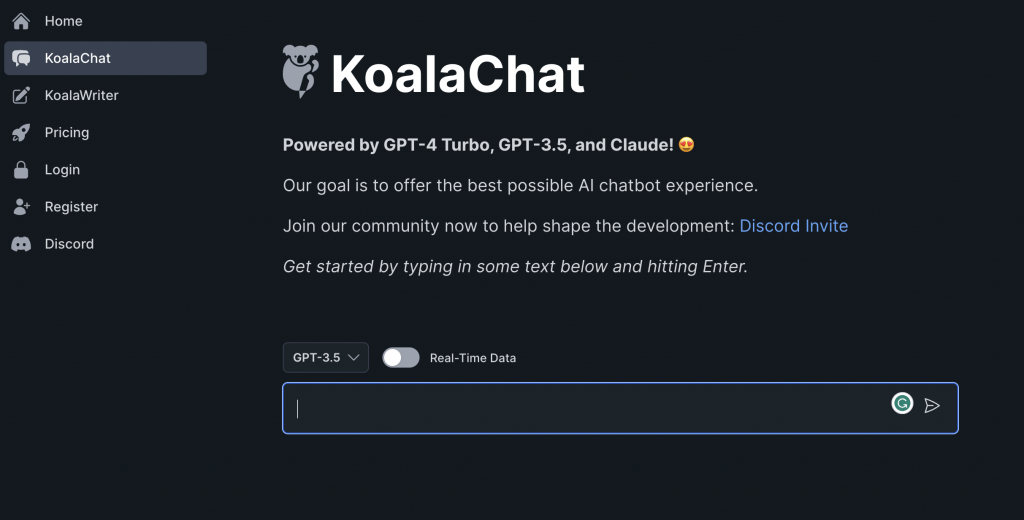
How does an AI chatbot work?
AI chatbots operate thanks to natural language processing (NLP) and machine learning. NLP is like a set of data and rules that help a computer understand the meaning behind written text. Machine learning is the tech that lets chatbots continuously get better. The computer keeps analyzing its responses and user inputs to offer higher-quality answers down the line.
Here’s a brief explanation of how artificial intelligence processes users’ inputs and gives answers:
- Input analysis. When you type your question into a chatbot, it breaks down the sentences into smaller parts like individual words or phrases. This process is called tokenization. After that, artificial intelligence figures out the grammatical role of each separate part and classifies them like people, places, actions, and so on.
- Intent recognition. During this step, the AI works on figuring out what the user needs. For example, it tries to understand whether you’re asking a question, requesting something, or sharing your thoughts. This is done using methods that recognize patterns and analyze the meaning behind words.
- Context understanding. Even though AI chatbots sometimes forget previous conversations, some can give answers based on information they already have from users, like marketing data. Nonetheless, it’s important to be careful with this because AI may be trained on confidential information which imposes potential business risks.
- Response generation. To come up with a reply, AI relies on its databases. Thanks to the language model, the chatbot figures out how to put words together.
- User interaction. If you didn’t like the response provided by the chatbot, you can let it know through a message. Then, artificial intelligence will analyze your feedback and provide more relevant information.
- Self-learning. Thanks to machine and deep learning tech, artificial intelligence can teach itself. The more you chat with the system and give your feedback, the smarter that particular chatbot gets.
How to use an AI chatbot effectively
If you’re generating responses using AI chatbots, you may notice that they can provide inaccurate or repetitive information. To improve results, utilize the following tips:
- Understand a specific chatbot’s purpose. Although most chatbots are built on similar language models, developers often customize them for specific purposes. These can be solving math problems, generating text, or engaging in friendly conversation. If you need a chatbot for a specific purpose, examine its goals and capabilities.
- Provide context. Users often expect unique responses from chatbots without providing any information. For example, if you’re generating marketing texts, it’s crucial to specify the target audience and the preferred tone of voice. Imagine that the chatbot is like a copywriter who needs detailed guidelines to create a good text.
- Experiment with prompts. Most user requests look like this: “Write me a social media post on topic X” or “Provide statistics in the industry.” Such prompts are very vague. It’s better to input as many details as possible. For example, specify the year for the required statistics and where to find information sources. Currently, there are entire platforms with prompts that significantly enhance AI’s performance. For example, there is Sintra.
- Specify necessary details. If a chatbot provides inaccurate information, you can correct it and ask for the text to be rewritten. Remember, it’s always important to double-check the data given by artificial intelligence, as it may turn out to be inaccurate.
- Ask follow-up questions. If you’re studying a particular topic or aiming to write higher-quality material, always ask additional questions. For example, you can inquire about who holds a specific point of view in the text that the chatbot provided you.
- Provide feedback. If you liked the response, let the chatbot know. Developers intentionally include this functionality to encourage users to contribute to the system improvement.
How to choose the best AI chatbot
- Define your needs and requirements. These can be copywriting, education, healthcare, or coding. Also, every chatbot has its own distinct writing style, which also plays a crucial role in your choice.
- Consider data integration options. If you require more than just searching for information (solving specific tasks), this can be a useful feature. For example, some chatbots can integrate with other applications, like a Google account, or allow you to upload your unique data.
- Opt for chatbots with additional features. Language model selection, accessibility on various devices, an up-to-date database, etc can significantly ease your work.
- Look for customization options. If there is the option to choose a writing style, various content types, and customization to match your unique style, that’s a big plus.
- Ensure security and privacy. Many artificial intelligence-based solutions collect user data, which can be sensitive. It’s best to ensure that the AI chatbot has a reliable privacy policy. Moreover, input-generated images can’t be used in brand promotions due to terms of use.
- Check language support. If you need to create content in different languages, consider this feature. Plenty of chatbots perform well in English, but struggle with the grammatical structure of other languages. Experiment with different solutions to find what works best for you.
To sum up
AI chatbots are like your personal assistants and, sometimes, even make for interesting conversation buddies. They take the hassle out of many everyday tasks, like planning work schedules, crafting texts, lead generation, and handling customer support. Some can even offer professional psychological support. But keep in mind that each chatbot has been trained on dissimilar datasets, so they’re better at different things. Give them all a try and discover the ones that genuinely make life a whole lot easier.
Other articles that may interest you
Benefits and Risks of Using Generative AI for Business
How The Use of AI-generated Images Can Jeopardize Brand Trust

